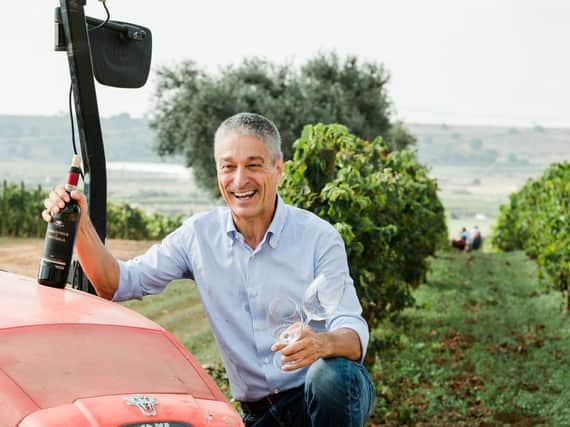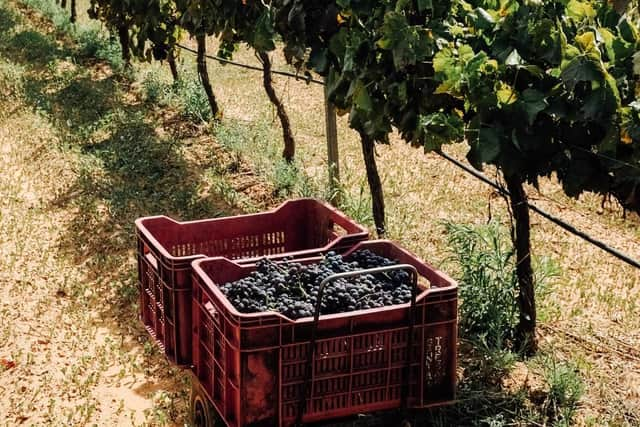Sicily isn't only a great holiday destination it also produces some excellent wines


After all it is not too far, so if plans have to change then it is easy to get home. And summer comes early in Sicily, so if there is a chance of getting away by May or June, the weather will be glorious.
Another benefit is that, once you get out into the countryside, there is plenty of space and there is a constant breeze, moderating the heat of the sun.
Advertisement
Hide AdAdvertisement
Hide AdSicily has transformed its winemaking in the last 20 years. It used to be the source of huge quantities of strong, indeterminate wines that were blended away, adding depth and power to many weaker Italian wines.


But now it has an identity of its own, mainly brought about by a few determined winemakers who have carved out a personality for Sicilian wines by adopting high standards of viticulture and winemaking.
Stefano Girelli is one of these winemakers. Around 25 years ago he swapped his role in the family company making large volumes of perfectly adequate Italian wines, to focus on Sicily, and above all, organic viticulture.
Now Sicily is his only focus. He has bought two wine estates, which is an achievement in itself, since he is from the north of Italy. The most recent acquisition of a small family-run estate took six years of negotiation with the 82-year-old owner who insisted that Girelli not only kept to her long-established organic routines, but also kept the name of the estate.
Advertisement
Hide AdAdvertisement
Hide AdThat wouldn’t normally be a problem, but the name of the estate, Cortese, is the same as the name of a grape, which adds a layer of confusion.
Both properties are in Vittoria, in the province of Ragusa, south-eastern Sicily. All of the island is gorgeous.
Its vast swathes of countryside and long sandy beaches are remarkably empty and it has a serious dose of history with Roman amphitheatres and temples cropping up all over. There is also Mount Etna which occasionally gives cause for concern, but when I was last there, it just boomed from time to time and there was a glow from the summit at night.
Stefano Girelli is convinced that Sicily is perfect for organic viticulture with no chemicals or pesticides used in the vineyards. “We have sunshine for ripening, but we can also create shade in the vineyards. We have long dry autumns so there is never any pressure on picking dates; we just wait for the perfect time.
Advertisement
Hide AdAdvertisement
Hide Ad“We also have nutrient-rich soil, on a bed of limestone which can trap moisture so the vines can survive the mainly dry summer. We have also invested in a local reservoir so the vines are irrigated using rainwater, and don’t deplete the natural water supply in the soil.”
With routine planting of beans to enrich the soil, a naturally beneficial climate and a determination to bring back some of Sicily’s traditional grape varieties, his two estates, Santa Tresa and Cortese, are now making some of Sicily’s most fascinating wines.
Sicily has a number of traditional indigenous grapes, some of which you may not have come across before so this is what they taste like.
Carricante: A white grape whose name means “heavily laden”, and the vine does produce a lot of grapes, but if pruned well it makes a wine full of fresh citrus fruit with a fine, elegant structure and a honeyed note.
Advertisement
Hide AdAdvertisement
Hide AdGrillo: Sicily’s famous white grape widely planted for use in Marsala, but it can also be used for table wine. It has lively, lemon acidity with good structure and herbal notes.
Frappato: A red grape with fresh fruity, floral notes, Frappato makes a light, cherry red wine with strawberry flavours and a definite streak of freshness – almost Beaujolais in character. It is used in a blend with Nero d’Avola to create the specialist wine of Vittoria, Cerasuolo di Vittoria.
Nerello Mascalese: Indigenous to the Mount Etna region, this is a stylish red grape with some genetic links to Sangiovese. This variety ripens late and builds a good level of alcohol with fresh acidity and bright red-fruit flavours.
Nero d’Avola: Sicily’s most widely planted red grape variety with a full body, deep colour and ageing potential. It has a taste of wild plums with good acidity, rounded tannins and dark savoury notes. It ages well developing complexity and depth.
Advertisement
Hide AdAdvertisement
Hide AdAs well as encouraging the use of local traditional grapes, Stefano Girelli is starting to use traditional winemaking methods. He has installed some terracotta amphorae for fermentation which add complexity to the wines.
Here are some new-style Sicilian wines to try...
Santa Tresa Grillo Spumante Brut, House of Townend, £11.99: Made sparkling in much the same way as Prosecco, but most importantly, from Grillo grapes, and fermented right through to Brut, so it is dry, this is a bright, floral wine that is perfect as an aperitif or poured alongside prawns and salmon.
Nostru Carricante 2018, Cortese Estate, House of Townend, £12.99, currently down to £10.99: A new listing at Townend, hence the bargain price, this white wine has lively citrus and herbal notes with a streak of minerality on the finish. Team with grilled sea bass.
Rosé di Santa Tresa, Majestic, £10.99 on a mix-six deal: Made from a blend of Nero d’Avola and Frappato, this is a delicate, delicious cherry-filled wine. Bone-dry and balanced, it makes a perfect aperitif.
Advertisement
Hide AdAdvertisement
Hide AdSanta Tresa Frappato Red 2019, Field & Fawcett, £10.95: This looks like a light Pinot Noir but tastes quite different. With raspberry and wild strawberry notes, plus a distinct edge of cranberry, it is a delicious fruity, lively wine that can be enjoyed with roast chicken or goose. Chill it in summer and pour alongside a tuna tartare, especially if there is basil on the plate.
Nostru Nerello Mascalese 2019. Cortese Estate, Yorkshire Vintners, £12: Bright ruby-red in colour with red fruits, a touch of spice and silky tannins. Perfect with grilled lamb.
Santa Tresa Nero d’Avola 2019, Rupe Secca, House of Townend, £8.99: A deep-coloured wine with flavours of plums, herbs and even a note of chocolate. This is a well-structured wine to go with casseroles.